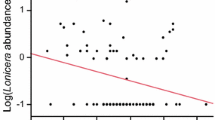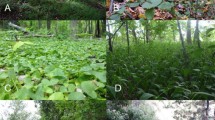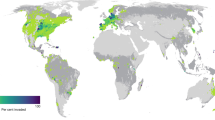Abstract
Context
Detecting biotic resistance to biological invasions across large geographic areas may require acknowledging multiple metrics of niche usage and potential spatial heterogeneity in associations between invasive and native species diversity and dominance.
Objectives
Determine (1) if native communities are resistant to biological invasions at macroscales; (2) the metrics that best quantify biotic resistance at these scales; and (3) the degree to which the direction and magnitude of invader-native associations vary with scale and/or location.
Methods
Using a mixed-effects modeling framework to account for potential sub-regional and cross-scale variability in invader-native associations, we modeled the species richness and cover of invasive plants in 42,626 plots located throughout Eastern USA forests in relationship to plot-level estimates of native tree biomass, species richness, and evolutionary diversity.
Results
We found (1) native tree biomass and evolutionary diversity, but not species richness, to be negatively associated with invader establishment and dominance, and thus indicative of biotic resistance; (2) evidence that evolutionary diversity limits invader dominance more than it does invader establishment; (3) evidence of greater invasion resistance in parts of the agriculturally-dominated Midwest and in and around the more-contiguous forests of the Appalachian Mountains; and (4) the magnitude to which native tree biomass and evolutionary diversity limit invasion varies across the ranges of these metrics.
Conclusions
These findings illustrate the improved understanding of biotic resistance to invasions that is gained by accounting for sub-regional variability in ecological processes, and underscores the need to determine the factors leading to spatial heterogeneity in biotic resistance.




Similar content being viewed by others
References
Akaike H (1973) Information theory as an extension of the maximum likelihood principle. In: Petrov BN, Caski F (eds) Proceedings, 2nd International Symposium of Information Theory. Akademiai Kiado, Budapest, pp. 267–281
Anderson DR, Burnham KP, Thompson WL (2000) Null hypothesis testing: problems, prevalence, and an alternative. J Wildl Manag 64(4):912–923
Araújo MB, Rozenfeld A (2014) The geographic scaling of biotic interactions. Ecography 37(5):406–415
Bates D, Maechler M, Bolker B, Walker S (2014) lme4: linear mixed-effects models using Eigen and S4. R package version 1.1-7. http://CRAN.R-project.org/package=lme4
Bechtold WA, Patterson PL (2005) The enhanced forest inventory and analysis program—national sampling design and estimation procedures. General Technical Report SRS-80. U.S. Department of Agriculture, Forest Service, Southern Research Station, Asheville
Catford JA, Jansson R, Nilsson C (2009) Reducing redundancy in invasion ecology by integrating hypotheses into a single theoretical framework. Divers Distrib 15(1):22–40
Catford JA, Vesk PA, Richardson DM, Pyšek P (2012) Quantifying levels of biological invasion: towards the objective classification of invaded and invasible ecosystems. Glob Chang Biol 18(1):44–62
Clark GF, Johnston EL (2011) Temporal change in the diversity–invasibility relationship in the presence of a disturbance regime. Ecol Lett 14(1):52–57
Cleland DT, Avers PE, McNab WH, Jensen ME, Bailey RG, King T, Russell WE (1997) National hierarchical framework of ecological units. In: Boyce MS, Haney A (eds) Ecosystem management applications for sustainable forest and wildlife resources. Yale University Press, New Haven, pp 181–200
Cleland DT, Freeouf JA, Keys JE, Nowacki GJ, Carpenter CA, McNab WH (2007) Ecological subregions: sections and subsections for the conterminous United States. General Technical. Report WO-76. U.S. Department of Agriculture, Forest Service, Washington, D.C. Map, presentation scale 1:3,500,000; Albers equal area projection; colored
Crawley MJ, Harral JE (2001) Scale dependence in plant biodiversity. Science 291(5505):864–868
Dark SJ, Bram D (2007) The modifiable areal unit problem (MAUP) in physical geography. Prog Phys Geogr 31(5):471–479
Davies RB (1987) Hypothesis testing when a nuisance parameter is present only under the alternative. Biometrika 74(1):33–43
Davis MA, Grime JP, Thompson K (2000) Fluctuating resources in plant communities: a general theory of invasibility. J Ecol 88(3):528–534
Dixon Hamil K, Huang W, Iannone BV, III, Fei S, Zhang H (2015) Analysis of multiscale ecological data. Landsc Ecol. doi:10.1007/s10980-015-0288-z
Efron B, Tibshirani R (1986) Bootstrap methods for standard errors, confidence intervals, and other measures of statistical accuracy. Stat Sci 1(1):54–75
Elton CS (1958) The ecology of invasions by animals and plants. Methuen, London
Faith DP (1992) Conservation evaluation and phylogenetic diversity. Biol Conserv 61(1):1–10
Faith DP (2002) Quantifying biodiversity: a phylogenetic perspective. Conserv Biol 16(1):248–252
Fei S, Phillips J, Shouse M (2014) Biogeomorphic impacts of invasive species. Annu Rev Ecol Evol Syst 45(1):69–87
Fridley JD, Stachowicz JJ, Naeem S, Sax DF, Seabloom EW, Smith MD, Stohlgren TJ, Tilman D, Holle BV (2007) The invasion paradox: reconciling pattern and process in species invasions. Ecology 88(1):3–17
Gavier-Pizarro GI, Radeloff VC, Stewart SI, Huebner CD, Keuler NS (2010) Housing is positively associated with invasive exotic plant species richness in New England, USA. Ecol Appl 20(7):1913–1925
Gilliam FS (2007) The ecological significance of the herbaceous layer in temperate forest ecosystems. Bioscience 57(10):845–858
Guo Q, Symstad A (2008) A two-part measure of degree of invasion for cross-community comparisons. Conserv Biol 22(3):666–672
Guo Q, Rejmanek M, Wen J (2012) Geographical, socioeconomic, and ecological determinants of exotic plant naturalization in the United States: insights and updates from improved data. NeoBiota 12:41–55
Guo Q, Fei S, Dukes JS, Oswalt C, Iannone BV III, Potter KM (2015) A unified approach to quantify invasibility and degree of invasion. Ecology 96:2613–2621
Heffernan JB, Soranno PA, Angilletta MJ, Buckley LB, Gruner DS, Keitt TH, Kellner JR, Kominoski JS, Rocha AV, Xiao J, Harms TK, Goring SJ, Koenig LE, McDowell WH, Powell H, Richardson AD, Stow CA, Vargas R, Weathers KC (2014) Macrosystems ecology: understanding ecological patterns and processes at continental scales. Front Ecol Environ 12(1):5–14
Helmus MR, Bland TJ, Williams CK, Ives AR (2007) Phylogenetic measures of biodiversity. Am Nat 169(3):E68–E83
Hulme PE (2009) Trade, transport and trouble: managing invasive species pathways in an era of globalization. J Appl Ecol 46(1):10–18
Iannone BV III, Oswalt CM, Liebhold AM, Guo Q, Potter KM, Nunez-Mir GC, Oswalt SN, Pijanowski BC, Fei S (2015) Region-specific patterns and drivers of macroscale forest plant invasions. Divers Distrib 21(10): 1181–1192
Ives AR, Carpenter SR (2007) Stability and diversity of ecosystems. Science 317(5834):58–62
Jenkins PT (1996) Free trade and exotic species introductions. Conserv Biol 10(1):300–302
Jeschke JM, Gómez Aparicio L, Haider S, Heger T, Lortie CJ, Pyšek P, Strayer DL (2012) Support for major hypotheses in invasion biology is uneven and declining. NeoBiota 14:1–20
Laliberté E, Legendre P (2010) A distance-based framework for measuring functional diversity from multiple traits. Ecology 91(1):299–305
Legendre P, Legendre L (2012) Numerical ecology. Elsevier Science B.V, Amsterdam
Levine JM, D’Antonio CM (1999) Elton revisited: a review of evidence linking diversity and invasibility. Oikos 87(1):15–26
Liebhold AM, McCullough DG, Blackburn LM, Frankel SJ, Von Holle B, Aukema JE (2013) A highly aggregated geographical distribution of forest pest invasions in the USA. Divers Distrib 19(9):1208–1216
Lockwood JL, Cassey P, Blackburn T (2005) The role of propagule pressure in explaining species invasions. Trends Ecol Evol 20(5):223–228
Lodge DM, Williams S, MacIsaac HJ, Hayes KR, Leung B, Reichard S, Mack RN, Moyle PB, Smith M, Andow DA, Carlton JT, McMichael A (2006) Biological invasions: recommendtions for U.S. policy and management. Ecol Appl 16(6):2035–2054
Lososová Z, de Bello F, Chytrý M, Kühn I, Pyšek P, Sádlo J, Winter M, Zelený D (2015) Alien plants invade more phylogenetically clustered community types and cause even stronger clustering. Glob Ecol Biogeogr 24(7):786–794
Martin PH, Canham CD, Marks PL (2009) Why forests appear resistant to exotic plant invasions: intentional introductions, stand dynamics, and the role of shade tolerance. Front Ecol Environ 7(3):142–149
Masek JG, Huang C, Wolfe R, Cohen W, Hall F, Kutler J, Nelson P (2008) North American forest disturbance mapped from a decadal Landsat record. Remote Sens Environ 112(6):2914–2926
McCann KS (2000) The diversity-stability debate. Nature 405(6783):228–233
McNab WH, Cleland DT, Freeouf JA, Keys JE, Jr, Nowacki GJ, Carpenter CA (2007) Description of ecological subregions: sections of the conterminous United States [CD-ROM]. General Technical Report WO-76B. U.S. Department of Agriculture, Forest Service, Washington, DC
Moore JC, Berlow EL, Coleman DC, de Ruiter PC, Dong Q, Hastings A, Johnson NC, McCann KS, Melville K, Morin PJ, Nadelhoffer K, Rosemond AD, Post DM, Sabo JL, Scow KM, Vanni MJ, Wall DH (2004) Detritus, trophic dynamics and biodiversity. Ecol Lett 7(7):584–600
Muller RN (2003) Nutrient relations of the herbaceous layer in deciduous forest ecosystems. In: Gilliam FS, Roberts MR (eds) The Herbaceous layer in Forests of Eastern North America. Oxford University Press, New York, pp 15–37
Oswalt C, Fei S, Guo Q, Iannone BV III, Oswalt S, Pijanowski B, Potter K (2015) A subcontinental view of forest plant invasions using national inventory data. NeoBiota 24:49–54
Pejchar L, Mooney HA (2009) Invasive species, ecosystem services and human well-being. Trends Ecol Evol 24(9):497–504
Petchey OL, Gaston KJ (2006) Functional diversity: back to basics and looking forward. Ecol Lett 9(6):741–758
Peters DC, Bestelmeyer BT, Turner MG (2007) Cross–scale interactions and changing pattern–process relationships: consequences for system dynamics. Ecosystems 10(5):790–796
Potter KM, Woodall CW (2012) Trends over time in tree and seedling phylogenetic diversity indicate regional differences in forest biodiversity change. Ecol Appl 22(2):517–531
Potter KM, Woodall CW (2014) Does biodiversity make a difference? Relationships between species richness, evolutionary diversity, and aboveground live tree biomass across U.S. forests. For Ecol Manag 321:117–129
Pyšek P, Jarošík V, Hulme PE, Kühn I, Wild J, Arianoutsou M, Bacher S, Chiron F, Didžiulis V, Essl F, Genovesi P, Gherardi F, Hejda M, Kark S, Lambdon PW, Desprez-Loustau M-L, Nentwig W, Pergl J, Poboljšaj K, Rabitsch W, Roques A, Roy DB, Shirley S, Solarz W, Vilà M, Winter M (2010) Disentangling the role of environmental and human pressures on biological invasions across Europe. Proc Natl Acad Sci 107(27):12157–12162
Ries P, Dix ME, Lelmini M, Thomas D (2004) National strategy and implementation plan for invasive species management. FS-805. U.S. Department of Agriculture, Forest Service, Washington, DC
Riitters KH, Wickham JD, O’Neill RV, Jones KB, Smith ER, Coulston JW, Wade TG, Smith JH (2002) Fragmentation of continental United States forests. Ecosystems 5(8):0815–0822
Schielzeth H (2010) Simple means to improve the interpretability of regression coefficients. Methods Ecol Evol 1(2):103–113
Shurin JB, Srivastava DS (2005) New perspectives on local and regional diversity: beyond saturation. In: Holyoak M, Liebold M, Holt RD (eds) Metacommunities: spatial dynamics and ecological communities. University of Chicago Press, Chicago, pp 399–417
Soranno PA, Schimel DS (2014) Macrosystems ecology: big data, big ecology. Front Ecol Environ 12(1):3–3
Soranno PA, Cheruvelil KS, Bissell EG, Bremigan MT, Downing JA, Fergus CE, Filstrup CT, Henry EN, Lottig NR, Stanley EH, Stow CA, Tan P-N, Wagner T, Webster KE (2014) Cross-scale interactions: quantifying multi-scaled cause–effect relationships in macrosystems. Front Ecol Environ 12(1):65–73
Spanos A (2014) Recurring controversies about P values and confidence intervals revisited. Ecology 95(3):645–651
Stohlgren TJ, Barnett DT, Kartesz JT (2003) The rich get richer: patterns of plant invasions in the United States. Front Ecol Environ 1(1):11–14
Tan J, Pu Z, Ryberg WA, Jiang L (2015) Resident-invader phylogenetic relatedness, not resident phylogenetic diversity, controls community invasibility. Am Nat 186(1):59–71
R Core Team (2013) R: A language and environment for statistical computing. R Foundation for Statistical Computing, Vienna, Austria. http://www.R-project.org
Tibshirani R, Leisch F (2013) Bootstrap: Functions for the Book “An introduction to the bootstrap”. R package version. 2012.04-1. http://CRAN.R-project.org/package=bootstrap
Turner MG (1989) Landscape ecology: the effect of pattern on process. Annu Rev Ecol Syst 20:171–197
Wardle DA (2002) Communities and ecosystems: linking the aboveground and belowground components. Princeton University Press, Princeton and Oxford
Wiens JA (1989) Spatial scaling in ecology. Funct Ecol 3(4):385–397
Woodall CW, Westfall JA (2010) Curious or spurious correlations within a national-scale forest inventory? In: McWilliams W, Roesch FA (eds), Monitoring Across Borders: 2010 Joint Meeting of the Forest Inventory and Analysis (FIA) Symposium and the Southern Mensurationists. e-General Technical Report SRS-157. U.S. Department of Agriculture, Forest Service, Southern Research Station, Asheville, pp. 39–43
Woodall CW, Heath LS, Domke G, Nichols M (2011) Methods and equations for estimating volume, biomass, and carbon for trees in the U.S. forest inventory, 2010. US Forest Service General Technical Report NRS-GTR-88. USFS Northern Research Statation, Newtown Square, pp. 30
Woodall CW, Westfall JA, Zhu K, Johnson DJ (2013) Assessing the effect of snow/water obstructions on the measurement of tree seedlings in a large-scale temperate forest inventory. Forestry 86(4):421–427
Wu J, Hobbs R (2002) Key issues and research priorities in landscape ecology: an idiosyncratic synthesis. Landscape Ecol 17(4):355–365
Acknowledgments
We would like to thank the many FIA workers who collected the data used in this investigation; Beth Schulz, Andrew Gray, and Chris Witt for helping to compile the data; Johanna Desprez and Jarrod Doucette for GIS-related advice; and two anonymous reviewers for their constructive criticisms and suggestions on how to improve this paper. This research was supported by NSF Macrosystems Biology Grant # 1241932 and by a Research Joint Venture Agreement 13-JV-11330110-043 and Cost Share Agreement 14-CS-11330110-042 between the USDA Forest Service and North Carolina State University.
Author information
Authors and Affiliations
Corresponding author
Additional information
Special issue: Macrosystems ecology: Novel methods and new understanding of multi-scale patterns and processes.
Guest Editors: S. Fei, Q. Guo, and K. Potter.
Electronic supplementary material
Below is the link to the electronic supplementary material.
Supplementary material 1
Appendix A1 (DOCX 622 kb)
Supplementary material 2
Table A2 (DOCX 20 kb)
Supplementary material 3
Table A3 (DOCX 16 kb)
Supplementary material 4
Appendix A4 (DOCX 30 kb)
Rights and permissions
About this article
Cite this article
Iannone, B.V., Potter, K.M., Hamil, KA.D. et al. Evidence of biotic resistance to invasions in forests of the Eastern USA. Landscape Ecol 31, 85–99 (2016). https://doi.org/10.1007/s10980-015-0280-7
Received:
Accepted:
Published:
Issue Date:
DOI: https://doi.org/10.1007/s10980-015-0280-7




